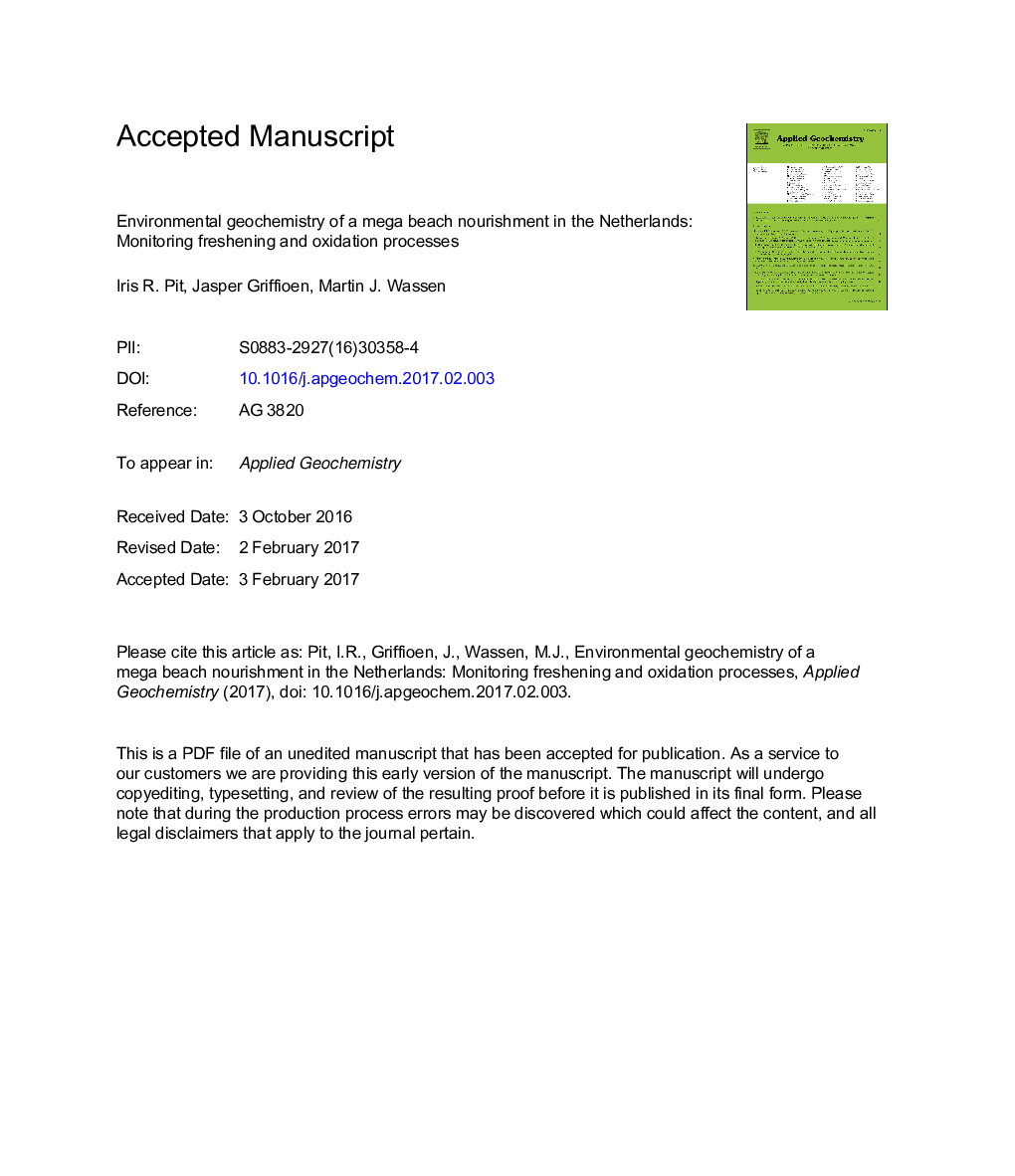| کد مقاله | کد نشریه | سال انتشار | مقاله انگلیسی | نسخه تمام متن |
|---|---|---|---|---|
| 5752583 | 1620211 | 2017 | 48 صفحه PDF | دانلود رایگان |
عنوان انگلیسی مقاله ISI
Environmental geochemistry of a mega beach nourishment in the Netherlands: Monitoring freshening and oxidation processes
ترجمه فارسی عنوان
ژئوشیمی محیطی از تغذیه ساحلی مگا در هلند: نظارت بر فرآیندهای تازه سازی و اکسیداسیون
دانلود مقاله + سفارش ترجمه
دانلود مقاله ISI انگلیسی
رایگان برای ایرانیان
کلمات کلیدی
آنالیز خوشه ای، تجزیه و تحلیل عامل فاکتور، اکسیداسیون پریت، مدیریت ساحلی، رسوب، آب های زیرزمینی،
موضوعات مرتبط
مهندسی و علوم پایه
علوم زمین و سیارات
ژئوشیمی و پترولوژی
چکیده انگلیسی
As coastal lowlands are prone to sea water flooding, sea-level rise might globally increase this risk. To protect its coastline, the Netherlands adds an average of 12 million m3 of sand annually, but more is needed to cope with the expected consequences of global warming. In 2011 a novel approach for coastal protection was applied near The Hague, consisting of a mega beach nourishment of 21.5 million m3 of sand: the Sand Engine - an artificial sand spit rising to 6Â m above mean sea level. It uniquely combines coastal engineering construction with environmental, ecological and social considerations. To construct the Sand Engine, material was used from the seafloor, which changed the materials environment from anaerobic to aerobic, triggering two main hydrogeochemical processes: pyrite oxidation and groundwater freshening. The objective of this study was to assess the sediment geochemistry of the Sand Engine and understand the hydrogeochemistry with respect to pyrite oxidation and freshening. When sufficient buffer capacity is lacking, the mobility of metals and metalloids originated from the mineral pyrite, can cause local impacts on ecology and environment. Geochemical and multivariate statistical analyses were performed on 174 sediment samples from the Sand Engine and from material collected from the seafloor prior to its construction, as well as on 86 samples of pore water collected from the Sand Engine. First, a cluster analysis was performed, using model-based (Mclust) and variable clustering. Second, a robust factor analyses (RFA) was used to explain the variation between the groups and discover relationships between elements and/or soil properties within the groups. We distinguished three clusters of sediment samples and two clusters of pore water samples. Sediment cluster 1 was comprised exclusively of surface samples from the Sand Engine; it was differentiated from the other two clusters by its geochemistry, sorting processes and weathering. Sediment clusters 2 consisted of shallow samples from the Sand Engine, as well as deeper autochthone material from the sand pit. Sediment cluster 3 contained deeper samples from the Sand Engine and also shallow autochthone material from the sand pit. Sediment clusters 2 and 3 show differences in carbonate content and, especially, in reactive iron, confirming that in the sand pit area a Holocene marine layer overlies Pleistocene fluvial sand. For the pore water samples, two clusters were estimated: a saline water cluster and a fresh water cluster. Thus the Sand Engine contains source material from two different geological layers, which vary in their reactive iron concentration and carbonate minerals. Pyrite oxidation is seen with depth, resulting in iron oxides and an increase in alkalinity because of calcite dissolution. With the development of the Sand Engine source material is expected to show a decrease in pyrite oxidation, because of low amount of available sulphide minerals. Carbonate dissolution due to pyrite oxidation will then decrease as well. Additional calcite dissolution is caused by freshening processes. With the amount of CaCO3 present in the sand, the Sand Engine contains calcareous-rich sand where acidic conditions are not likely to occur during its life span and therefore create no local environmental risks for acidification. At the surface of the mega beach nourishment, sorting processes are causing locally enrichment of iron oxides and associated elements, as well as a decrease in the stability of heavy minerals like rutile.
ناشر
Database: Elsevier - ScienceDirect (ساینس دایرکت)
Journal: Applied Geochemistry - Volume 80, May 2017, Pages 72-89
Journal: Applied Geochemistry - Volume 80, May 2017, Pages 72-89
نویسندگان
Iris R. Pit, Jasper Griffioen, Martin J. Wassen,
